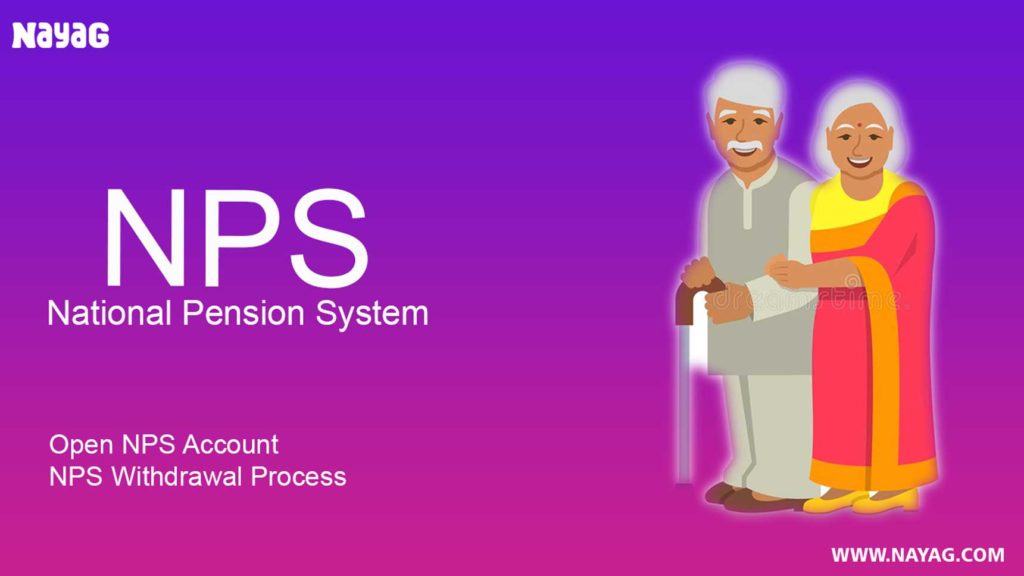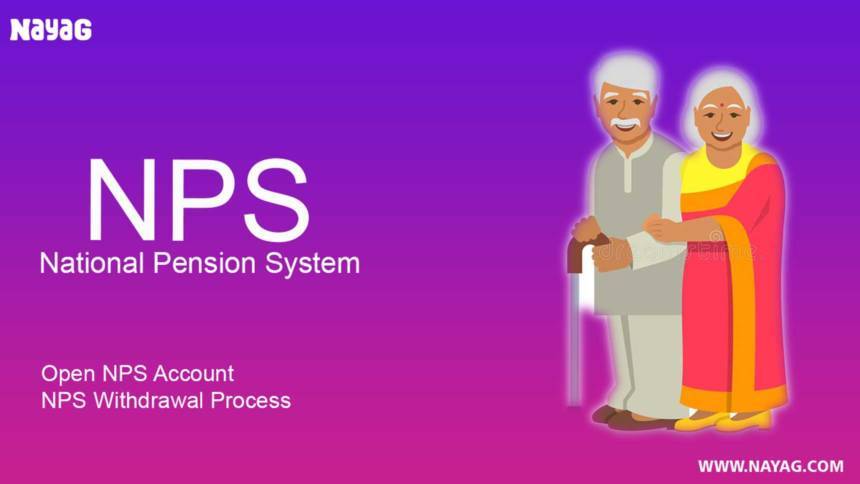The National Pension System(NPS) is a long-term and voluntary investment scheme that helps its subscribers after retirement.
NPS Information
| Tenure | Can invest till the age of 65 years |
| Interest rate | 8% to 12% p.a. |
| Investment Amount | Starting at Rs.250 |
| Maturity Amount | Depends on the investment amount |

Introduced in 2004, The National Pension System (NPS) was previously available only for the Central Government employees. However, it was made available for all Indian citizens in 2009. The scheme is regulated by the Pension Fund Regulatory and Development Authority (PFRDA).
Also Read- PM Schemes List
Procedure To Open an NPS Account
Individuals can open an NPS account both online and offline. Given below is the procedure to open an NPS account both online and offline:
- Online procedure:
- Visit the eNPS website (https://enps.nsdl.com/eNPS/NationalPensionSystem.html) to register online.
- Your mobile number, Aadhaar number, and Permanent Account Number (PAN) must be linked with the NPS account.
- Validate the registration using the OTP which will be sent to your registered mobile number.
- On completion of registration process, you will receive a Permanent Retirement Account Number or PRAN. The PRAN can be used in the future to log in to your profile.
- Offline procedure:
- Visit the nearest Point of Presence (PoP) centre, a bank, or a post office to open an NPS account.
- You will have to submit your Know Your Customer (KYC) documents along with a duly filled up and signed application form.
- The PoP centre will send you a PRAN once you have made your first investment.
- The PRAN along with a password will be present in the welcome kit. The PRAN and password will be required to operate your account.
- You will also be required to pay a one-time registration fee of Rs.125.
NPS Withdrawal Process
- Exit rule and early withdrawal under NPS: It is vital that subscribers make investments towards the scheme until they reach 60 years of age as NPS is a pension scheme. However, under certain circumstances, subscribers can withdraw up to 25% of the invested amount if they have invested towards the account for 3 years. Given below are the different cases under which early withdrawal is allowed:
- In case the children of the subscriber are getting married
- For higher studies
- For buying or building a house
- In case of medical treatment of the subscriber or his/her family members
NPS Withdrawal is possible for a maximum of 3 times under the scheme and there must be a minimum gap of at least 5 years between withdrawals. The early withdrawal process is applicable to only Tier-I account. Under Tier-II accounts, the entire investment can be withdrawn.
- Withdrawal after attaining the age of 60: The entire investment made towards the scheme cannot be withdrawn once the subscriber reaches the age of 60 years old. It is mandatory that subscribers retain at least 40% of the investment in order to receive a pension. The pension is given to subscribers from an insurance firm that is registered under the PFRDA. The remaining 60% can be withdrawn and no tax needs to be paid on it.
Also Read-
- Atal Pension Yojana
- Voluntary Provident Fund
- Employees’ Provident Fund
- Public Provident Fund
- Flipkart Offers Today
- SBI FASTag Apply
Documents Required for Withdrawal NPS Amount
Given below is the list of documents that must be submitted in order to withdraw the amount from NPS:
- Withdrawal form
- Original PRAN card
- Proof of identity that has been attested must be submitted
- A cancelled cheque must be submitted
Union Budget 2020 Highlights Regarding NPS
As per the Budget 2020 that was announced by the Minister of Finance and Corporate Affairs, Nirmala Sitharaman, a proposal has been made to introduce a limit of Rs.7.5 lakh for any contributions made by the employer towards the National Pension System, Pension Fund, and superannuation fund.
The Finance Minister further added that any amount that is contributed beyond this limit will be taxable. This move will likely impact employees who have a high basic salary. Under the current rule, any contributions made by the employer towards the NPS and the Pension Fund are tax exempt without any specific ceiling.
For example, in case your basic salary is Rs.35 lakh, the employer’s contribution could be Rs.9.20 lakh. This is inclusive of the Rs.1.5 lakh towards the superannuation fund, Rs.4.2 lakh towards the Pension Fund and Rs.3.5 lakh towards NPS.
Different Types of NPS Accounts
Tier-I and Tier-II are the two types of NPS accounts. While the Tier-I is a mandatory account, the Tier-II is a voluntary account. The differences between the two accounts are mentioned in the table below:
| Category | Tier-I account | Tier-II account |
|---|---|---|
| Maximum contribution | No limit to the amount of contribution | No limit to the amount of contribution that is made towards the account |
| Minimum contribution | Rs.500 or Rs.1,000 in a year must be made towards the account | Rs.250 must be made towards the account |
| Tax deductions | Subscribers are eligible for a tax deduction of up to Rs.2 lakh. | Subscribers are not eligible for tax deductions under the account. |
| Withdrawals that are allowed | Subscribers cannot withdraw the investments made towards the account until they retire. | Subscribers will be able to withdraw the contributions made towards the account. |
| Status | It is a mandatory account for subscribers who register for an NPS account. | Subscribers can open the account on a voluntary basis. |
The NPS account is mandatory for all Central Government employees. They will have to contribute 10% of their basic salary towards NPS. The NPS scheme is voluntary for all other Indian citizens.
Differences Between NPS & other Tax Saving Schemes
Some of the other schemes that provide NPS tax benefits under Section 80C of the Income Tax Act are Tax-saving Fixed Deposits (FD), Public Provident Fund (PPF), and Equity Linked Savings Scheme (ELSS). Given below is the table where the difference between NPS and the schemes mentioned above are compared:
| Type of scheme | Rate of interest (p.a.) | Fixed period of investment | Risks of the scheme |
|---|---|---|---|
| NPS | The expected rate of interest is between 8% to 10% | Investment towards the scheme is till retirement | The returns on investments are market-related. |
| FD | The rate of interest is guaranteed and is from 7% to 9%. | 5 years | The scheme is risk-free. |
| PPF | The rate of interest is guaranteed and is 8%. | 15 years | It is a risk-free scheme. |
| ELSS | The expected rate of interest is from 12% to 15%. | 3 years | The returns depend on the market. |
Even though the returns that are generated from the scheme may be higher than PPF and FD, however, there are no tax benefits on maturity. Individuals who withdraw 60% of the total investments that have been made towards the account, should know that 20% of that amount is taxable. However, the taxable amount may vary.
National Pension Scheme
NPS Features
The main features of the scheme are mentioned below:
- Eligibility: Indian citizens who are between 18 years and 65 years of age and do not come under any NPS sector are eligible to invest in NPS scheme.
- Cost for registration: Initially, individuals must pay Rs.500 (exclusive of taxes) towards registering for an NPS account.
- Contribution towards NPS: The minimum contribution that must be made towards the scheme is Rs.500 (not including taxes). There is no upper limit to the maximum contribution that can be made. However, the minimum contribution that can be made in a Tier-I account is Rs.1,000 in a financial year.
- Number of contributions: Subscribers must make at least one contribution in a financial year.
- Modes of payment: Payments can be made in the form of Demand Draft (DD), cheque, and cash.
- Change of scheme and fund manager: In case subscribers are not happy with the overall performance of the scheme, they are allowed to change the fund manager or the pension scheme. Both the Tier-I and the Tier-II accounts come with these options.
Tax Benefits Under NPS
In case you wish to make any additional contributions towards the Tier I account, you can visit enps.nsdl.com or visit any Point of Presence – Service Providers (POP-SP). The transaction statement can be submitted as proof of investment.
According to the current provisions, under Section 80 CCD (1) of the Income Tax Act, the NPS account holder can claim tax benefits of up to 10% of his/her gross income. However, a maximum of Rs.1.5 lakh can be claimed as tax benefits under Section 80 CCE of the Income Tax Act. Under Section 80CCD (1B), an additional amount of Rs.50,000 can be availed as tax benefits for any contributions made towards the scheme.
Also Read-
- Pradhan Mantri Suraksha Bima Yojana
- Ayushman Bharat Yojana
- Sukanya Samriddhi Yojana
- Pradhan Mantri Kisan Samman Nidhi
- Pradhan Mantri Jeevan Jyoti Bima Yojana
NPS Rules of Allocation
Investments are made in various schemes by the NPS. Investment is made towards equity under Scheme E of the NPS. Subscribers can contribute up to 50% of their total investments towards equities. Active choice and auto choice are the two different options of investments that are available.
- Active choice: Under active choice, the scheme and the type of split can be decided by the subscriber.
- Auto choice: Under auto choice, depending on the subscriber’s age, the option decides the risks of the investment. Therefore, less risky and more stable investments are chosen if the subscriber is older.
- KYC Documents Required to Enroll for NPS
The following documents are required to be submitted at the time of making the application:
- Subscriber registration form
- Photo ID proof
- Proof for Date of Birth
- Proof of residence
- Different Modes of Payments
The following modes are accepted by SBI for NPS premium payments:
- Direct payment at an SBI Life branch
- Through standing order on credit card
- Online payments
- Electronic Clearing Service
- Payments through SBI Life’s mobile app
- Through National Automated Clearing House (NACH)
- Through POS terminals at authorized SBI Life branches
FAQ’s on NPS
Following retirement, are employees engaged in government service eligible for leave encashment as per the guidelines of the NPS?
No. Leave encashment is not allowed as per the guidelines of NPS laid down by the CCS and does not count as a component of the benefits available to the employee after retirement.
What is the reason behind the compulsory utilization of a minimum of 40% of the accumulated pension funds to buy annuities after retirement?
The main reason behind this move is to ensure employees in government service will still obtain a regular and stable income every month following their retirement.
Which body is responsible for the calculation of interest with regards to the NPS?
The interest is calculated by the The Pension Accounting Office, who is the official body appointed for this particular task.
Which agency or office will be responsible for contribution deductions In the event of the transfer of an employee during the course of the month?
The office that draws the salary of the subscriber for the maximum amount of time during the month will be responsible for the deduction of contribution towards the NPS.
What are the KYC documents required to enroll for NPS through SBI?
The following documents are required to be submitted at the time of making the application:
Subscriber registration form
Photo ID proof
Proof for Date of Birth
Proof of residence
What are the different modes of payments available with SBI Pension Funds Pvt. Ltd.?
The following modes are accepted by SBI for NPS premium payments:
Direct payment at an SBI Life branch
Through standing order on credit card
Online payments
Electronic Clearing Service
Payments through SBI Life’s mobile app
Through National Automated Clearing House (NACH)
Through POS terminals at authorized SBI Life branches
How to check the status of your NPS account in SBI?
Simply login to the SBI Life customer portal and fill in details such as Customer ID and NPS policy number to view your current status.
What are the minimum contribution amounts for Tier I and Tier II accounts?
The minimum contribution amount for Tier I accounts is Rs.500 per month and that for Tier II accounts is Rs.250 per month. Subscribers should also maintain a minimum balance of Rs.6000 for Tier I and Rs.2000 for Tier II at the end of the year.
How does SBI settle the NPS claims?
You need to submit the settlement form along with the essential documents for claim settlement at the branch where you maintain your NPS account. For details on claim settlements you can send an email to claims@sbilife.co.in. The final decision on claims will be based on the disclosures made in the proposal form by the subscriber.
Who provides annuity on withdrawal or maturity under NPS?
The insurance companies licensed by the IRDA and authorized by the PFRDA act as the annuity service providers to NPS subscribers.
Is NPS an easily accessible system of long term investments?
NPS is a cost effective, flexible and portable retirement savings scheme in which the wealth accumulated depends on the contributions made by the individual.
How many subscribers does NPS have?
The total number of NPS subscribers as on 30 Dec, 2016 is 1,02,76,250.
What are the features of NPS app?
Using the NPS app, you can raise a request for transaction statement for the particular fiscal year. You can also view the details of scheme wise units and update your contact information.
We hope you have enjoyed our work, if you liked it Please help us reach more people like You. Share this article with your Friends using below buttons. Sharing is Caring 💗







